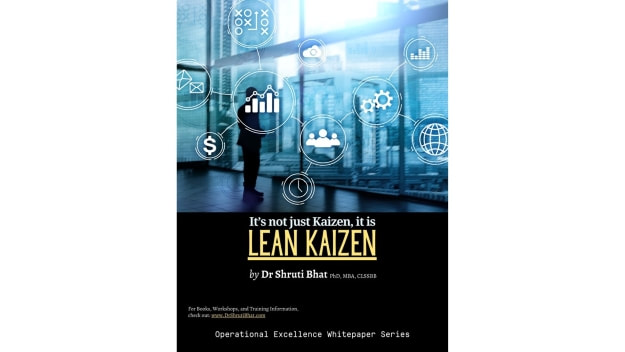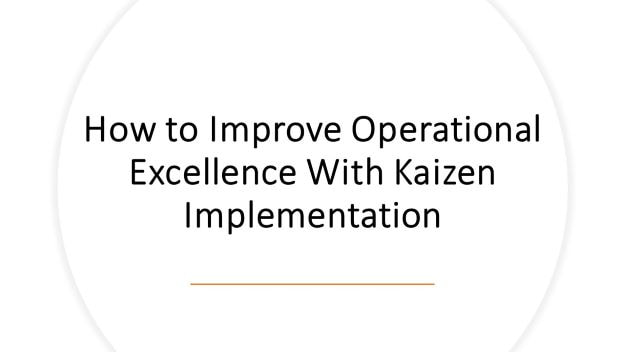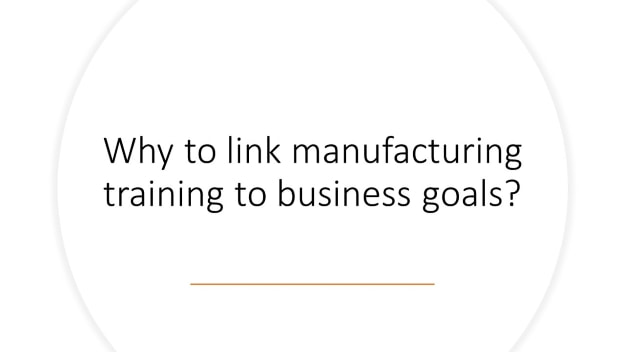Lean Kaizen is a continuous improvement methodology to get rid of excess waste involved in a process. Lean identifies waste as- Muda (waste in manufacturing system), muri (waste due to overburden) and mura (waste created due to unevenness of workloads). Kaizen is the foundation of Lean methods of production and focuses largely on reducing, or eliminating waste, increasing productivity, and attaining continual improvement of organizational processes.
Lean Kaizen incorporates Kaizen’s ideas of continual improvement and focuses on making/ applying small changes for a significant amount of time, to achieve desired results. This method involves all types of employees (i.e. full-time, part-time, contract etc.) at different levels within the company and requires complete involvement by everyone, to allow anyone to speak up regarding problems being faced at the workplace and ways of improvement.
The main technique often used here involves analytical aspect and includes methods such as ‘5-Whys’ and ‘Ishikawaka’ to pinpoint ways of reducing waste in certain areas of production. A Kaizen implementation plan is then designed, which is often applied almost immediately. The solutions involved are typically minute and more solutions are added as problems arise.
It is necessary to assess and follow up on the actions for improvement, to be able to analyze how well the plan is working and to make sure that it continues to be applied for a long period. The system of Kaizen allows all employees to have a say in the decision-making and boosts employee morale within a company. Since this method is continuous in action, employees can choose to speak up on issues when they occur – which allows for solutions to make a significant impact. Therefore, solutions via Lean Kaizen methodology are absolutely customized to the type of problems occurring in a section or department. Hence, Lean Kaizen creates a customized solution not only specific to an industry segment but it is company- specific too.
Though Kaizen does appear to focus on fixing manufacturing process related problems, it is also used to improve the organization as a whole. Hence, Lean Kaizen plays a critical role in overall business process improvement.
Anything that positively contributes to the safety, efficiency or productivity of the organization is greatly valued in Lean Kaizen methodology. While employees can come up with ideas at their own leisure, it is often encouraged by organizations to arrange brainstorming sessions on a regular basis. Typically, in a brainstorming session, employees are given a topic to focus on and discuss possibilities of improvement regarding the given subject.
It is most effective for these brainstorming or Kaizen sessions to include around five to seven people. The numbers vary on the company size, markets of operation, employee strength, number, frequency, and magnitude of problems etc. Organizations targeting improvement via Lean Kaizen should generally allow for employees that are involved in the session to have some time off during their workday to come up with solutions. The reason Kaizen sessions work well is because different viewpoints are heard and can help bring about a solution that works for all.
Lean Kaizen is extremely difficult to implement in life sciences companies viz. pharmaceuticals, herbal products etc. Lean advocates small batch sizes. Improper use of Lean Kaizen on a pharmaceutical company shop floor produces poor operational output. For example- small batch sizes may mean higher percentage of granules wasted on a high-speed tablet-press, while working on low-speed tablet machines would directly impact productivity negatively.
Implementing ‘one piece flow’ i.e. a process in which each product moves through the production process, one unit at a time, is difficult to implement in the traditional pharmaceutical manufacture of capsules, tablets and other dosage forms. One piece flow might, however, work with additive manufacturing i.e. 3D printing.
Furthermore, pharmaceutical manufacturing requires meticulous cleaning and line clearance between batches, unless it is a dedicated line for a product. To avoid line clearance procedures for dedicated lines, batches must have same blend compositions and products be dose proportionate. What that means is- if a tableting line produces Product A having multiple strengths 100 mg, 150 mg, 200 mg and 300 mg, then batch of 100 mg label claim must be manufactured first, followed by others in ascending chronology.
In all other scenarios, such as, non-dedicated lines, different blend compositions and/or non-dose-proportionate products, obtaining line clearance between batches is a must. This stipulation disallows quick changeovers on the shop floor. For example, a clean-in-place process may require a full day and line clearance may not be received as test results may not be available to QA. Such incidences usually happen since line clearance tests are complex and take time. For example- if a microbiology study is involved, line clearance test results may get delayed by 5-15 days!
Lean manufacturing technique cannot be applied as-is to pharmaceutical Ops. However, Lean principles combined with Kaizen philosophy can be applied to improve pharmaceutical operational productivity, control WIP, reduce cycle times, variations and enhance process efficiency.
Some of the key scenarios where improvement via Lean Kaizen is extremely helpful:
- Ailing business needs a turnaround.
- Little or no leadership from top management.
- Persistent cashflow problem.
- Infrequent management reviews.
- Top talent not used adequately.
- Poor support from finance, IT, maintenance team, human resources, marketing, R&D functions to manufacturing.
- Trouble-shooting expertise within manufacturing is inadequate.
- High manufacturing overhead.
- Company wants to implement advanced manufacturing techniques, go for automation, digitalization etc.
- Poor collaboration between various functions within the organization.
- The focus is on training, not on improvement.
- Poor communication of initiatives and progress- tracking.
- Lack of appropriate recognition and rewards.
- Projects not tied to business goals.
- Poorly defined project goals, scope, and metrics.
- Project management effectiveness is poor, for example- too many scope creeps, projects going over-budget or over-timelines etc.
- Wrong project teams.
- Infrequent team meetings.
- Quality problems in processes, products, and services.
- Too many non-compliances cited during audits.
- Delays with procurement and irregularities with supply chain.
- Vendor management needs to be improved.
- Delays with hiring. Too many open positions in the organization.
- Backorders at shopfloor; demand not met despite infrastructure capability.
- Lot of reworks.
Benefits of Lean Kaizen:
Lean Kaizen methodology involves making small changes within an organization and implementing these changes on a continuous basis. These improvements allow organizations to reduce waste and improve productivity. The method involves all workers of the company and allows everyone to have a say regarding possibilities of improvement, as well as pinpointing methods that are not efficient or could be made better. Unlike workshops that take place annually or monthly, Lean Kaizen is implemented regularly and continuously.
The ideas that are addressed in Lean Kaizen are often small since this method works effectively when small changes are made. These small changes tend to improve important aspects of the company such as efficiency, safety, and productiveness. Aside from working on aspects that are deemed problematic within a process, Lean Kaizen also encourages workers to speak up regarding all aspects of improvement.
The best advantage of Lean Kaizen is that it greatly reduces waste. This can include waste from transportation, supply chain logistics, skills, inventory, processes, and production. It also lowers costs, increases safety, allows for more efficient delivery, and improves customer satisfaction.
Another advantage of implementing Lean Kaizen is that it creates a lot of clutter-free space due to the elimination of unnecessary items. It also increases the quality of the product, uses assets in a better manner, improves communication and allows employees to feel valued in the company. Since employees are a significant part of the Kaizen campaign, they feel empowered and contribute to the organization’s cause in a big way and tend to augment their loyalty and dedication.
Employees that are continuously assessing their environment to find methods of improvement have a higher chance of addressing necessary changes within the workspace. Since employees that are involved tend to have higher morale, they work more effectively and experience more job satisfaction.
Since Lean Kaizen focuses on making small changes, the results are immediate. When an organization chooses to undergo large changes, it takes much more time to see results and there may be several negative drawbacks as well.
It is still necessary for companies to undergo large changes for certain projects. However, Lean Kaizen has a positive effect on the entire process by making it easier to implement in increments and to analyze detailed aspects as well as the bigger picture.
The reason Lean Kaizen is widely used and favored is because it is a continuous method that continually makes little improvements, that greatly improves the processes of an organization and lowers waste.
Lean Kaizen is used by life sciences companies throughout the world and continues to work well for organizations of all sizes and segments. However, it is good to be aware of the limitations of Lean Kaizen before implementing this method to your organization.
Limitations of Lean Kaizen:
A large drawback of Lean Kaizen is that it requires organizations to change their governance style and communication methods. It can be hard for companies that are used to working in a certain way, to suddenly make changes to their work style. For Lean Kaizen to take off the ground, companies must allow open communication and empower employees to speak up on issues around their workplace. Lean Kaizen will not work at all sans transparent dialogues between everyone in the workplace.
Another limitation noted in Lean Kaizen is that this method focuses largely on reducing waste, which can withdraw focus from other important aspects. Change management procedures must be extremely efficient to make the Lean Kaizen campaign a success.
Usually implementing Lean Kaizen has a positive spin on employees (since they are valued), however, it can rake-up fear of losing their jobs or may feel threatened because changes at workplace might displace them from their ‘comfort zone’.
It is necessary for all employees to be well-informed and aware of the real reasons for implementing Lean Kaizen. Otherwise, the drive that motivated workers during the initial stages can dwindle down over time. This is especially harmful if the solutions have not yet been put to action. The organization will not receive the desired results and can deter employees from wanting to continuously use Kaizen strategy.
Implementing Lean Kaizen can be quite stressful since it becomes a new focal point within the organization. It can cause the work area to become more detached and objective since employees may feel continuous pressure to exceed their prior performances. If stress levels in workers become too high, then it can have a negative effect on both efficiency and productivity of the workforce.
Conclusion:
Implementing Lean Kaizen principles for process optimization in pharmaceutical manufacturing is a journey that requires commitment, teamwork, and continuous effort. However, the benefits are well-worth the investment. By focusing on continual improvement, waste reduction, standardization, and employee engagement, pharmaceutical companies can achieve greater operating efficiency, higher product quality, and a competitive edge within the sector.
Lean Kaizen's principles align with the pharmaceutical industry's commitment to providing safe, efficacious, cost- effective and patient-centric medications while striving for innovation and operational excellence. Learn more about how Kaizen can help your company here.
An important point to note is that Lean Kaizen is a top-down methodology, so it starts at the top of the management ladder. Company leaders must believe in the Lean Kaizen philosophy and visualize ways to use Lean Kaizen to improve their business. Next this vision and Lean Kaizen mission must percolate down in the organization so that employees are excited to participate in the process improvement campaign. Do you know, a highly motivated Lean Kaizen workforce can bring about big process improvements in as less as 7 days!
If you are looking to install strategic Lean Kaizen process improvement initiatives at your workplace, let's talk...
Contact us at https://www.drshrutibhat.com/contact.html
Checkout more on Lean Kaizen in my book Kaizen for pharmaceutical, medical device and biotech industries.
Related reading:
- How to cut costs strategically using Kaizen
- Revolutionizing industries with Lean Six Sigma
- Streamline processes and workflows with Gemba Walk.
- Top Ten Strategic Decision-Making Tools for Operational Excellence
- Popular Continuous Improvement Workshops & Webinars for Manufacturing Industries
- Mistake-Proofing Pharmaceutical Product Development, Manufacturing and Logistics, Cost Savings via Poka Yoke
- Popular Continuous Improvement Tools.
Follow Shruti on Twitter, YouTube, LinkedIn
Categories: Whitepaper | Kaizen | Operational Excellence
Keywords and Tags:
#Kaizenforpharma #LeanKaizen #ContinuousImprovement #ProcessImprovement #ProcessEfficiencyImprovement #BusinessProcessImprovement #BusinessTransformation #JapaneseKaizen #KaizenEvents #processoptimization



























